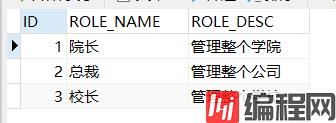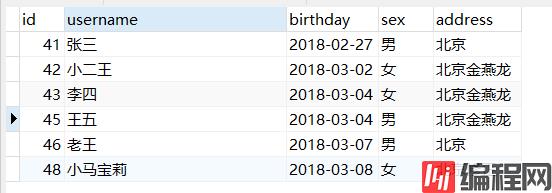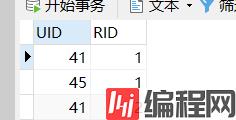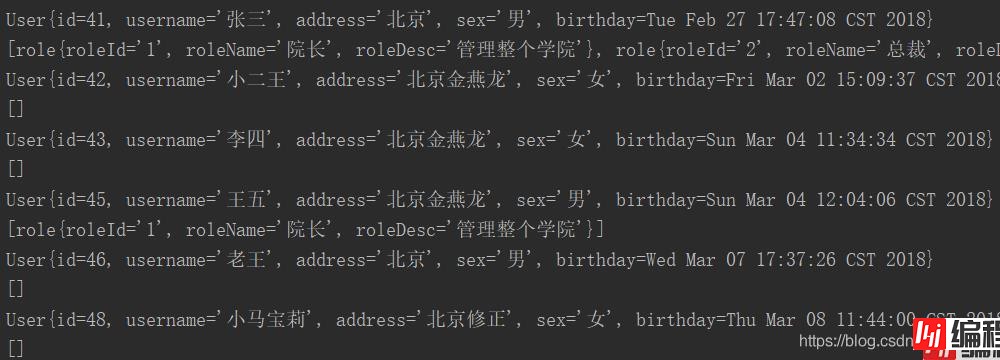Python 官方文档:入门教程 => 点击学习
mybatis 注解实现一对多关联查询 @Select("select id,mockexam_section as section,id as sectionId"
@Select("select id,mockexam_section as section,id as sectionId"
+ " from t_p_qb_mockexam_section"
+ " where mockexam_charpter_id = #{charpterId} and is_delete = 0"
+ " order by mockexam_section_idx asc")
@Results({
@Result(property = "questionList",column = "sectionId",many = @Many(select = "com.zikaoshu.baseinfo.mapper.BaseinfoQuestionMapper.listQuestionResDto"))})
List<SectionQuestionDto> listSectionQuestionDto(@Param("charpterId") Integer charpterId);
@Select("select id,type,discuss_title as discussTitle,stem1,material,a,b,c,d,e,answer,analysis,mockeaxm_section_id as sectionId"
+ " from t_p_qb_question_mockexam"
+ " where mockeaxm_section_id = #{id} and is_delete = 0"
+ " order by q_sequence,gmt_create asc")
List<QuestionResDto> listQuestionResDto(@Param("id") Integer id);前面总结了一对一,多对一和一对多的多表查询,今天总结一下多对多的mybatis多表查询。同样有xml方式和注解方式,步骤和前两种查询差不多,最主要的区别就在表和sql语句上了。
这里采用用户和角色的例子
一个用户可以有多个角色
一个角色可以赋予多个用户
在进行多表查询时,我们需要一张中间表,中间表中包含各自的主键,在中间表中是外键。



这次我们首先清理一下思路,我们先在数据库里把我们需要的数据查出来再写代码。
我们查询用户时要同时查出其对应的角色,借助中间表,根据UID查询RID,再根据RID查询角色表,中间表的数据我们不需要,所以不显示。
这里我们可以用左外连接来进行多表的查询,查询所有用户,用户有角色信息就连接到该用户后面,没有则为空。
select u.*,r.id as rid,r.ROLE_NAME,r.ROLE_DESC from user u
left outer join user_role ur on u.id=ur.uid
left outer join role r on ur.rid = r.id

当我们查询角色想要得到相应的用户时道理是一样的,SQL语句也只要换一下连接顺序。
select u.*,r.id as rid,r.ROLE_NAME,r.ROLE_DESC from role r
left outer join user_role ur on r.id=ur.rid
left outer join user u on ur.uid = u.id

查询出来结果后剩下的内容就很简单。
在User和role里加入多对多实体映射
public class Role implements Serializable {
private String roleId;
private String roleName;
private String roleDesc;
//多对多映射关系,一个角色有多个用户
private List<User> users;
public List<User> getUsers() {
return users;
}
public void setUsers(List<User> users) {
this.users = users;
}
public String getRoleId() {
return roleId;
}
public void setRoleId(String roleId) {
this.roleId = roleId;
}
public String getRoleName() {
return roleName;
}
public void setRoleName(String roleName) {
this.roleName = roleName;
}
public String getRoleDesc() {
return roleDesc;
}
public void setRoleDesc(String roleDesc) {
this.roleDesc = roleDesc;
}
@Override
public String toString() {
return "role{" +
"roleId='" + roleId + '\'' +
", roleName='" + roleName + '\'' +
", roleDesc='" + roleDesc + '\'' +
'}';
}
}
public class User implements Serializable{
private Integer id;
private String username;
private String address;
private String sex;
private Date birthday;
//多对多映射关系,一个用户具备多个角色
private List<Role> roles;
public List<Role> getRoles() {
return roles;
}
public void setRoles(List<Role> roles) {
this.roles = roles;
}
@Override
public String toString() {
return "User{" +
"id=" + id +
", username='" + username + '\'' +
", address='" + address + '\'' +
", sex='" + sex + '\'' +
", birthday=" + birthday +
'}';
}
public Integer getId() {
return id;
}
public void setId(Integer id) {
this.id = id;
}
public String getUsername() {
return username;
}
public void setUsername(String username) {
this.username = username;
}
public String getAddress() {
return address;
}
public void setAddress(String address) {
this.address = address;
}
public String getSex() {
return sex;
}
public void setSex(String sex) {
this.sex = sex;
}
public Date getBirthday() {
return birthday;
}
public void setBirthday(Date birthday) {
this.birthday = birthday;
}
}
然后配置xml,配置映射封装和sql语句
<!--定义resultMap-->
<resultMap id="userWithRole" type="user">
<id property="id" column="id"></id>
<result property="username" column="username"></result>
<result property="address" column="address"></result>
<result property="sex" column="sex"></result>
<result property="birthday" column="birthday"></result>
<!--配置角色映射-->
<collection property="roles" ofType="role">
<id property="roleId" column="rid"></id>
<result property="roleName" column="role_name"></result>
<result property="roleDesc" column="role_desc"></result>
</collection>
</resultMap>
<!--查询所有用户信息-->
<select id="findAll" resultMap="userWithRole">
select u.*,r.id as rid,r.ROLE_NAME,r.ROLE_DESC from user u
left outer join user_role ur on u.id=ur.uid
left outer join role r on ur.rid = r.id
</select>
<resultMap id="roleUserMap" type="role">
<id property="roleId" column="rid"></id>
<result property="roleName" column="role_name"></result>
<result property="roleDesc" column="role_desc"></result>
<collection property="users" ofType="user">
<id property="id" column="id"></id>
<result property="username" column="username"></result>
<result property="address" column="address"></result>
<result property="sex" column="sex"></result>
<result property="birthday" column="birthday"></result>
</collection>
</resultMap>
<!--查询所有角色信息-->
<select id="findAll" resultMap="roleUserMap">
select u.*,r.id as rid,r.ROLE_NAME,r.ROLE_DESC from role r
left outer join user_role ur on r.id=ur.rid
left outer join user u on ur.uid = u.id
</select>
测试结果


思路是一样的,但我们使用注解时,不能像xml方式一样只使用一条sql语句完成直接封装,所以这里要按上面说的思路完成分步查询。
public interface IUserDao {
@Select("select * from user")
@Results(id = "userRoleMap",value = {
//id表示主键
@Result(id = true,column = "id",property = "id"),
@Result(column = "username",property = "username"),
@Result(column = "address",property = "address"),
@Result(column = "sex",property = "sex"),
@Result(column = "birthday",property = "birthday"),
@Result(property = "roles",column = "id",many = @Many(select = "com.itcc.dao.IRoleDao.findByUid",fetchType = FetchType.LAZY))
})
List<User> findAll();
@Select("select * from user where id in(select uid from user_role where rid = #{rid})")
@Results({
@Result(id = true,column = "id",property = "id"),
@Result(column = "username",property = "username"),
@Result(column = "address",property = "address"),
@Result(column = "sex",property = "sex"),
@Result(column = "birthday",property = "birthday")
})
List<User> findByRId(Integer rid);
}
public interface IRoleDao {
@Select("select * from role")
@Results({
@Result(id = true,column = "id",property = "roleId"),
@Result(column = "role_name",property = "roleName"),
@Result(column = "role_desc",property = "roleDesc"),
@Result(property = "users",column = "id",many = @Many(select = "com.itcc.dao.IUserDao.findByRId",fetchType = FetchType.LAZY))
})
List<Role> findAll();
@Select("select * from role where ID in(select rid from user_role where uid = #{uid})")
@Results({
@Result(id = true,column = "id",property = "roleId"),
@Result(column = "role_name",property = "roleName"),
@Result(column = "role_desc",property = "roleDesc")
})
List<Role> findByUid(String uid);
}
最终的测试结果和上面一样。
以上为个人经验,希望能给大家一个参考,也希望大家多多支持编程网。
--结束END--
本文标题: mybatis如何使用注解实现一对多关联查询
本文链接: https://www.lsjlt.com/news/130111.html(转载时请注明来源链接)
有问题或投稿请发送至: 邮箱/279061341@qq.com QQ/279061341
下载Word文档到电脑,方便收藏和打印~
2024-03-01
2024-03-01
2024-03-01
2024-02-29
2024-02-29
2024-02-29
2024-02-29
2024-02-29
2024-02-29
2024-02-29
回答
回答
回答
回答
回答
回答
回答
回答
回答
回答
0